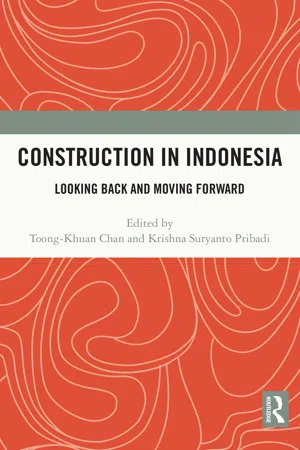1.1 Brief History of Indonesia
Dutch control over Indonesia was exerted initially by the Dutch East India Company or VOC from the seventeenth century that established trading posts in Banten and later in Batavia. The collapse of the company in 1800 resulted in its nationalization and direct Dutch control over its possessions. Control was ceded temporarily to the English from 1806 to 1816 before the Dutch colonial government was re-established. This latter period of Dutch colonialism is characterized by three distinct eras and corresponding colonial policies. In 1830, the Dutch introduced the cultivation system of imposed cultivation of export crops by the local agricultural community to support the ailing economy back in Holland. This system of agricultural production, where local farmers were obliged to hand over a portion of their harvests to the Dutch, generated around 33% of the total Dutch state income between 1860 and 1866 (Indonesia Investments, 2021). In 1870, the cultivation system was replaced by the liberal policy where private capital was welcomed into the capital-intensive plantation agriculture, extractive industries, banking, and shipping (Benda, 1965). By 1901, under increasing humanitarian concern for the welfare of the native population, and to justify continued Dutch colonial rule, a period of ethical policy was instituted to gradually modernize Indonesia. Benda (1965) asserted that impetus for Dutch colonial rule in Indonesia was always economic, and that the half-hearted modernization was just a means to prevent social disintegration and opposition to colonialization. Colonial rule by the Dutch was abruptly interrupted by the Second World War.
Early signs of Indonesian nationalism started with the founding of the Bandung Study Club in 1926 with Sukarno as its secretary (Britannica, 2021). The idea of a struggle for independence without any alignment with Islamic or communist ideals found resonance with young Indonesian students and the public at large. Several other leaders such as Mohammad Hatta and Sutan Sjahrir established Partai Nasional Indonesia (PNI) in response to nationalist sentiments. Sukarno, Hatta and Sjahrir were at various times arrested and exiled until the fall of the Dutch East Indies to Japan early in 1942. After the defeat of the Japanese in Southeast Asia, Sukarno and Hatta unilaterally declared Indonesia as an independent republic on 17 August 1945.
Dutch attempts to reassert control over Indonesia found strong resistance including a protracted battle in Surabaya. The Dutch finally transferred sovereignty over its colony to the United States of Indonesia in December 1949. Until the first national elections in 1955, Indonesia was governed by a multitude of political parties representing various interests; Islamic, communist, and nationalist, under an informal arrangement of proportional representation. The decade between 1949 and 1957 was tumultuous with successive changes in governments and a disillusionment with self-governance. In view of the unruly democracy, President Sukarno declared martial law in 1957 and instituted ‘guided democracy’ to preserve the country’s unity and sense of national identity (CIA Factbook, 2021).
On 1st October 1965, a group of army conspirators calling itself the 30th of September movement kidnapped and murdered six army generals in an attempted coup. President Sukarno had been taken into custody as a protective measure. It was later revealed that General Suharto, commander of the army’s special forces had seized power. Sukarno was forced to delegate extensive powers to Suharto and was installed as President three years later in March 1968. Sukarno was kept under house arrest until his death on 21 June 1970 (Britannica, 2021).
The new regime which Suharto designated as the New Order aimed to attain political stability and economic rehabilitation after two previous decades of political turmoil and instability. Indonesia’s foreign debts were renegotiated, and foreign aid was sought from a group of donor countries. New private capital investment was encouraged. Economic stability was achieved with a decreasing rate of inflation, the rupiah exchange rate stabilized, manufacturing expanded rapidly, and petroleum production increased. This period was characterized by the influx of foreign capital, the creation of an affluent merchant class and a widening gap between the rich and poor. These New Order policies brought about spectacular economic achievements. Java, the most populated island saw rapid expansion in manufacturing and a corresponding growth in incomes. Suharto’s economic strategies to spread development evenly across Indonesia and to integrate the provinces into the country won widespread support. However, by the late 1990s, there was growing discontent that strategic economic sectors in Indonesia were controlled by the family of Suharto, a coterie of cronies and enterprises linked to the military.
Early signs of the Asian Financial Crisis surfaced in July 1997 when the Thai baht was under severe selling pressure and fell from a peg of 25 baht to the US dollar to half its value by January 1998. The monetary crisis quickly spread to Indonesia where the private sector found that repayments for loans denominated in US dollars had increased substantially when the Indonesian rupiah (IDR) fell from IDR 4,000 per US dollar before the crisis to IDR 14,000 in 1998. Suharto sought assistance from the International Monetary Fund (IMF) to bring immediate relief, but requisite reforms to the banking sector and the economy were delayed for many years, in turn further delaying the recovery of the Indonesian economy.
As the economic situation continued to deteriorate, mass uprisings and protests against Suharto’s government led to his resignation on 21 May 1998. On the same day, Vice President Bacharuddin Jusuf Habibie was sworn in as the new president. The fall of Suharto saw the election of four presidents who all served short terms in office. This period, often referred to as the age of reform, was characterized by increased freedom of the press and public demands for the development of a strong democracy and effective law enforcement (Britann...
